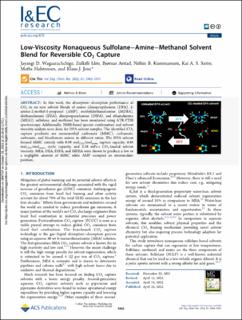| dc.contributor.author | Wagaarachchige, Jayangi Dinesha | |
| dc.contributor.author | Idris, Zulkifli | |
| dc.contributor.author | Arstad, Bjørnar | |
| dc.contributor.author | Kummamuru, Nithin Bharadwaj | |
| dc.contributor.author | Sætre, Kai Arne | |
| dc.contributor.author | Halstensen, Maths | |
| dc.contributor.author | Jens, Klaus-Joachim | |
| dc.date.accessioned | 2022-10-26T07:14:56Z | |
| dc.date.available | 2022-10-26T07:14:56Z | |
| dc.date.created | 2022-09-22T10:52:17Z | |
| dc.date.issued | 2022 | |
| dc.identifier.citation | Wagaarachchige, J. D., Idris, Z., Arstad, B., Kummamuru, N. B., Sætre, K. A. S., Halstensen, M. & Jens, K.-J. (2022). Low-Viscosity Nonaqueous Sulfolane–Amine–Methanol Solvent Blend for Reversible CO2 Capture. Industrial & Engineering Chemistry Research, 61(17), 5942-5951. | en_US |
| dc.identifier.issn | 0888-5885 | |
| dc.identifier.uri | https://hdl.handle.net/11250/3028299 | |
| dc.description.abstract | In this work, the absorption–desorption performance of CO2 in six new solvent blends of amine (diisopropylamine (DPA), 2-amino-2-methyl-1-propanol (AMP), methyldiethanolamine (MDEA), diethanolamine (DEA), diisopropanolamine (DIPA), and ethanolamine (MEA)), sulfolane, and methanol has been monitored using ATR-FTIR spectroscopy. Additionally, NMR-based species confirmation and solvent viscosity analysis were done for DPA solvent samples. The identified CO2 capture products are monomethyl carbonate (MMC), carbamate, carbonate, and bicarbonate anions in different ratios. The DPA solvent formed MMC entirely with 0.88 molCO2/molamine capture capacity, 0.48 molCO2/molamine cyclic capacity, and 3.28 mPa·s CO2-loaded solvent viscosity. MEA, DEA, DIPA, and MDEA were shown to produce a low or a negligible amount of MMC while AMP occupied an intermediate position. | en_US |
| dc.language.iso | eng | en_US |
| dc.rights | Navngivelse 4.0 Internasjonal | * |
| dc.rights.uri | http://creativecommons.org/licenses/by/4.0/deed.no | * |
| dc.title | Low-Viscosity Nonaqueous Sulfolane-Amine-Methanol Solvent Blend for Reversible CO2 Capture | en_US |
| dc.type | Peer reviewed | en_US |
| dc.type | Journal article | en_US |
| dc.description.version | publishedVersion | en_US |
| dc.rights.holder | © 2022 The Authors. Published by American Chemical Society. | en_US |
| dc.source.pagenumber | 5942-5951 | en_US |
| dc.source.volume | 61 | en_US |
| dc.source.journal | Industrial & Engineering Chemistry Research | en_US |
| dc.source.issue | 17 | en_US |
| dc.identifier.doi | https://doi.org/10.1021/acs.iecr.1c04946 | |
| dc.identifier.cristin | 2054239 | |
| cristin.ispublished | true | |
| cristin.fulltext | original | |
| cristin.qualitycode | 2 | |

